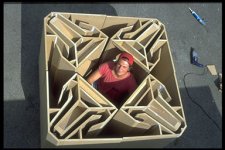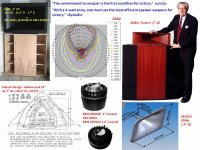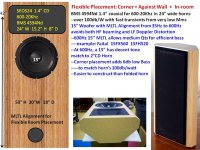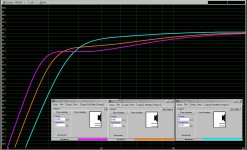Like? Or are you playing Brockian ultra-cricket?
I'm watching where you point that tennis gun....
As Bare says, it's not a simple or easy answer. All will be compromises. A 2A3 has just enough power to run a 604 or similar coax in a small to medium room for large classical. The problem with classical is that is has such a large dynamic range. Good recordings have an average to peak ratio of 22dB or more. That means you can need 160X to 250x more power on the peaks than on the average levels.
Pop music is far less dynamic.
If you want to get close to a realistic sound on orchestral music, you need to go big. Big speakers, no matter what the drivers. Small speakers will always sound small on orchestral music.
Don't worry about Altec being called "mid-rangey", if you have a proper crossover it is not at all. Tannoy is no different. Also the notion that low efficiency is somehow lower distortion is also false. Don't believe it.
I have heard SET amps with 45 and 2A3 output tubes do extremely well on small combo jazz and vocals when driving big, high efficiency speakers. Large scale classical is more difficult.
Agreed. One thing I want to add is, if OP can consider active crossover multiple amp system, it would solve all the contradiction.
Best sound I ever got with 2A3 amps was triamped straight front horns (with subs that could keep up) PP EL84 on the midbass, 2A3 on upper midrange low treble, and 45 amps on highs. I use the 2A3 amps now to drive headphones - never could get the noise floor low enough to work with the 110 Db sensitive mid horns. Driving a full range speaker system with 2A3 to realistic symphony levels is difficult to near impossible.
...But despite active filtering, the cheap dac section make them not sounding natural for acoustic music like classical or jazz ! imho.
You can also consider a good two way + plated amp sub.
I guess you're talking about something like minidsp, but the active can be done with analog discrete or computer + multiple ch pro DAC...
Two way + sub can be a very nice solution, I think.
If you want to do big orchestra properly with small power, you have to go big. No way around it. And it is difficult.
If you want smaller speakers, go bigger power. To me, smaller speakers with low power are like Jenga towers on big dynamic swells; separation and timbre just collapse.
I compromised, push-pull 6B4G's (6.3v filament octal 2A3); JBL based 3-way, 15" direct radiator w/ tractrix mid horn, 93dB +/-. I loved my SE 45 amp, but I don't have the time/space/funds for suitable speakers right now. And I likely would have to bi-amp the bottom anyway.
If I could, I would try K-horn corner bins with tractrix or LeCleach mids.
If you want smaller speakers, go bigger power. To me, smaller speakers with low power are like Jenga towers on big dynamic swells; separation and timbre just collapse.
I compromised, push-pull 6B4G's (6.3v filament octal 2A3); JBL based 3-way, 15" direct radiator w/ tractrix mid horn, 93dB +/-. I loved my SE 45 amp, but I don't have the time/space/funds for suitable speakers right now. And I likely would have to bi-amp the bottom anyway.
If I could, I would try K-horn corner bins with tractrix or LeCleach mids.
Last edited:
Eldam, as you probably know, there was a version of the Onken cabinet for a 12" Altec and an even smaller version that used a 10" Focal woofer. Both were good, but did sound scaled down compare to the big boxes. I could certainly live with the 12.
I owned for a time a University Sound mini VOTT. It used a 12" woofer and looked like a small A7 cabinet. Never did really care for it, and was never sure why.
I owned for a time a University Sound mini VOTT. It used a 12" woofer and looked like a small A7 cabinet. Never did really care for it, and was never sure why.
I guess you're talking about something like minidsp, but the active can be done with analog discrete or computer + multiple ch pro DAC...
Two way + sub can be a very nice solution, I think.
Yes I was talking of such devices : good for the price but can not follow a good dac like an AYA 2 and Iancanada front end with very low jitter and sota clocks !
What you win on the active front is lost on the resolution and détails unluckilly ! I want myself buy a minidsp for toying but if I had more than one sota DAC I know I should go towards their I2S solution : no ADC anymore first then FIR workings while having sota dac chips and PS and analog output with I2S DACS like I have !
But I believe MiniDSP is improving more and more : I find also their RJ45 network DAC to be a real improvement as well instead spidf or USB ! Just wisch they improve more their I2S catalog of stuffs !
What I'm thinking at reading the post is a Khorn bass (eckhorn) and a biradial or Iwata or JMLC mid-high. With numerical active with 2 R2R soekris dac.
If I had the money, I would go with Trinnov Amethyst (I had a Trinnov à few years ago and it was great).
Wondering what drivers would be fine :
- 15 : altec, radian, other ?
- mid high compression driver : altec, BMS,....
What would you advice ?
For bass amp Hiraga Le Monstre or 20W
Sounds good ??
If I had the money, I would go with Trinnov Amethyst (I had a Trinnov à few years ago and it was great).
Wondering what drivers would be fine :
- 15 : altec, radian, other ?
- mid high compression driver : altec, BMS,....
What would you advice ?
For bass amp Hiraga Le Monstre or 20W
Sounds good ??
Le Monstre is certainly a nice alternativ if you don't want to go with tubes in the mid & highs, Le class A 20 W is for the bass (the 15" you speak about) or if you want just one amp to stay passive with one amp !
Have you talked to the people of Melaudia Forums already ? They are nice people and experienced with such high efficienty systems : Onken, horns... Sometimes they have the vidit of J Hiraga who is sharing his experience of good sound too !
We can't speak of a driver without its load !
Have you talked to the people of Melaudia Forums already ? They are nice people and experienced with such high efficienty systems : Onken, horns... Sometimes they have the vidit of J Hiraga who is sharing his experience of good sound too !
We can't speak of a driver without its load !
Jitter is a red herring in today's DACs. However, AM and FM distortion from your loudspeakers due to cone motion is an issue. Recommend horn-loaded bass (time aligned). See Red Shift: Doppler distortion in loudspeakers | Stereophile.com
I think that the downside of the active crossovers is far outstripped by their upside, especially with horn-loaded drivers. I'd recommend checking with someone that actually owns good actives and listen to them. Reading hi-fi magazines tends to be infect the mind with inaccurate and irrelevant hi-fi memes.
Chris
I think that the downside of the active crossovers is far outstripped by their upside, especially with horn-loaded drivers. I'd recommend checking with someone that actually owns good actives and listen to them. Reading hi-fi magazines tends to be infect the mind with inaccurate and irrelevant hi-fi memes.
Chris
I don't know if it's for me  !
!
Ok ! Replace the word Jitter by 'quality of digital inputt" if you prefer and you will hear it's not a red hering !
A dac can make sound good a speaker or very bad ! That was the sense of myt inputt, I believe most of the cheap active dac in active cheap devices are not musical friendly.
Many changes their sepakers and most should look at the quality of their source : the difference are as huge as two different speakers ! I believe it's even harder to find a good source trhan a good speaker ! But of course it's just my thoughts and Nothing to see with magasines !
I believe Active speaker is just a new fame of an old stuff which beginns to be democratic thanks to brands like MiniDSP but it's just the beginning in quality for this price ! The dac section are as bad as it was in the 80s' but it's easier today to keep the best of both world as you have the possibility to adds bricks despite the fdanger of the linking between them for the whole result (multiple pcb is not a good thing at high digital speed !)
Ok ! Replace the word Jitter by 'quality of digital inputt" if you prefer and you will hear it's not a red hering !
A dac can make sound good a speaker or very bad ! That was the sense of myt inputt, I believe most of the cheap active dac in active cheap devices are not musical friendly.
Many changes their sepakers and most should look at the quality of their source : the difference are as huge as two different speakers ! I believe it's even harder to find a good source trhan a good speaker ! But of course it's just my thoughts and Nothing to see with magasines !
I believe Active speaker is just a new fame of an old stuff which beginns to be democratic thanks to brands like MiniDSP but it's just the beginning in quality for this price ! The dac section are as bad as it was in the 80s' but it's easier today to keep the best of both world as you have the possibility to adds bricks despite the fdanger of the linking between them for the whole result (multiple pcb is not a good thing at high digital speed !)
Last edited:
"The commitment to conquer is the first condition for victory." sun tzu
"With a 3-watt army, one must use the most efficient speaker weapons for victory." diyAudio
BEST WEAPONS for 3-watt army
Corner Loading for +6db low frequency SPL.
For corner placement, a 90-degree horizontal pattern horn with 40-60 degree vertical pattern is necessary.
Using a Fc~300Hz horn, the BMS 4592Nd coaxial compression driver covers 450Hz-20kHz at 110db/watt. Moving mass is just a few grams, ideal for a 3-watt army.
K402, eJMLC 300, JBL 2384
The Klipsch Jubilee corner bass horn with two premium 12" woofers is measured at 105dbwatt. 41.7" W x 39.75" H x 24.5 D
=============
FLEXIBLE WEAPONS for 3-watt army
BMS 4594Nd 1.4” coaxial for 600-20Khz in 24” wide horns
--over 100db/W with fast transients from very low Mms
15” Woofer with MLTL Alignment from 35Hz to 600Hz avoids both HF beaming and LF Doppler Distortion
--Flexible Room Placement: Corner, Wall, OpenSpace
--Easier to construct than folded horn
--600Hz 15” MLTL allows medium Qts for efficient bass
----example: Faital 15FX560 15FH520, BMS 15N620,
--At 600Hz, a 15” has decent tone match to 2”CD Horn
"With a 3-watt army, one must use the most efficient speaker weapons for victory." diyAudio
BEST WEAPONS for 3-watt army
Corner Loading for +6db low frequency SPL.
For corner placement, a 90-degree horizontal pattern horn with 40-60 degree vertical pattern is necessary.
Using a Fc~300Hz horn, the BMS 4592Nd coaxial compression driver covers 450Hz-20kHz at 110db/watt. Moving mass is just a few grams, ideal for a 3-watt army.
K402, eJMLC 300, JBL 2384
The Klipsch Jubilee corner bass horn with two premium 12" woofers is measured at 105dbwatt. 41.7" W x 39.75" H x 24.5 D
=============
FLEXIBLE WEAPONS for 3-watt army
BMS 4594Nd 1.4” coaxial for 600-20Khz in 24” wide horns
--over 100db/W with fast transients from very low Mms
15” Woofer with MLTL Alignment from 35Hz to 600Hz avoids both HF beaming and LF Doppler Distortion
--Flexible Room Placement: Corner, Wall, OpenSpace
--Easier to construct than folded horn
--600Hz 15” MLTL allows medium Qts for efficient bass
----example: Faital 15FX560 15FH520, BMS 15N620,
--At 600Hz, a 15” has decent tone match to 2”CD Horn
Attachments
I'm on the same path, with a relatively more powerful DHT amp (type 50 instead of 2A3). It's my unjustified belief that much of what we like in classical music playback through real triodes can be attributed to circuits that employ less global feedback than more modern designs.
To be simplistic, any transducer with sensitivity less than 100 dB output per watt input measured at one meter (and that's only at a single frequency) cannot hope to reproduce the dynamic range of a good orchestra at full gallop.
Having attended orchestral performances that were genuinely loud, I'm no longer sure that's a worthy goal for home systems to emulate.
Lower distortion from the drivers and freedom from compression at higher power outputs come at the expense of pleasant breakup modes which seen inevitable.
I recommend a browse of Troels Gravesen's website which explores his approach to this pursuit, and details his solutions.
One of the most important things I took away from building one of his designs with his excellent JA8008 driver is avoiding crossovers in the range of human voices.
Where I part company with Troels is in assigning that to a tweeter as low as possible, and using the largest practical Mid/Bass driver.
Rather than deal with folded horns, large OB arrays or IB subs, I vote for a practical solution with multiple Acoustic suspension subs that have their own amps.
Like many here, I'm now building the SEOS Tempest kit, which is a reasonable compromise, to try getting orchestral music to sound lovely at home.
I would advise anyone exploring this to go hear a live concert at least once each year. Live music sounds very different than some of the most popular recordings, and that's an important touchstone for calibration of any transducer.
Go to a concert performing familiar music.
Become aware if the emotional response it evokes.
The transducer that wrings a taste of this from your records is doing something right.
Sent from my HP 10 G2 Tablet using Tapatalk
To be simplistic, any transducer with sensitivity less than 100 dB output per watt input measured at one meter (and that's only at a single frequency) cannot hope to reproduce the dynamic range of a good orchestra at full gallop.
Having attended orchestral performances that were genuinely loud, I'm no longer sure that's a worthy goal for home systems to emulate.
Lower distortion from the drivers and freedom from compression at higher power outputs come at the expense of pleasant breakup modes which seen inevitable.
I recommend a browse of Troels Gravesen's website which explores his approach to this pursuit, and details his solutions.
One of the most important things I took away from building one of his designs with his excellent JA8008 driver is avoiding crossovers in the range of human voices.
Where I part company with Troels is in assigning that to a tweeter as low as possible, and using the largest practical Mid/Bass driver.
Rather than deal with folded horns, large OB arrays or IB subs, I vote for a practical solution with multiple Acoustic suspension subs that have their own amps.
Like many here, I'm now building the SEOS Tempest kit, which is a reasonable compromise, to try getting orchestral music to sound lovely at home.
I would advise anyone exploring this to go hear a live concert at least once each year. Live music sounds very different than some of the most popular recordings, and that's an important touchstone for calibration of any transducer.
Go to a concert performing familiar music.
Become aware if the emotional response it evokes.
The transducer that wrings a taste of this from your records is doing something right.
Sent from my HP 10 G2 Tablet using Tapatalk
"The Klipsch Jubilee corner bass horn with two premium 12" woofers was measured at 105db/watt.
=============
--15” MLTL from 35-600Hz allows medium Qts for efficient bass--example: Faital 15FH520,
Klipsch has measurements showing that the Jubilee corner bass horn(41.7" W x 39.75" H x 24.5 D) with two premium 12" woofers has smoother SPL, slightly higher average SPL, and a smaller physical size than the original Klipschorn.
Simulations of the Faital 15FH520 woofer in 6,8,10 cuft ported box volumes illustrate the potential of ~100db/watt SPL 35Hz bass with corner placement gain. A tall MLTL with acceptable 28"-30" width is worth study for 3-watt amplifiers. Other potentially superior MLTL 15" woofers probably exist.
Attachments
- Home
- Loudspeakers
- Multi-Way
- What high efficiency speaker for Classical Music ?




